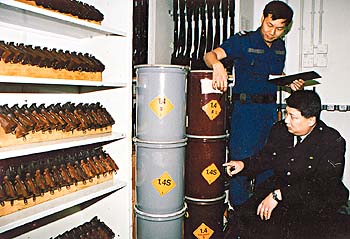Reader-friendly revamp for munitions manual
 Non-boom room: Bomb disposal officers check out the identification labels for dangerous substances in a PHQ munitions store |
More concise advice on the safe handling of dangerous goods is at hand under the new edition of the Force Ammunition Storage Regulations.
The second edition of the manual is now being distributed around formations and features simplified yet comprehensive advice, instructions and regulations on the safe storage, handling and transportation of ammunition and explosives. It also lays down procedures to be followed after incidents involving munitions.
Senior Bomb Disposal Officer Dominic Brittain said the second edition had been completely revised for officers' easier reference with more technical information and a more reader-friendly layout.
"It is a total 'how-to' guide on ammunition handling. The first edition which came out in 1996 was a trial run for officers on training courses and feedback we received suggested things could be more simple and better explained. So in this second edition we've attempted to do this and responses so far have been positive," Mr Brittain said.
"And we will continue to learn how all this can be better explained as we will also welcome feedback and suggestions on this second edition." The Explosive Ordnance Disposal Bureau has set up a site on the Police Intranet (POINT) system with the help of Service Quality Wing, which will feature updates for the manual that can be easily downloaded by officers to keep their regulations up to date.
Keeping contents concise has also improved the book's portability making it an important reference tool for officers which they can take when transporting munitions, take into an armoury or even into open-book examinations.
"Ammunition is extremely dangerous stuff - one of the most dangerous substances handled by man as it is like frozen energy which can go up in a moment. And even in countries with good controls on explosives there are still major accidents. So the manual is all about safety and trying to make Force operations as safe as possible for our officers and for the community," Mr Brittain said.
Due to the technicality of the subject, he stressed it was worth seeking advice when handling explosives and ammunition and reiterated the Bureau was happy to help through a simple phone call. He added that the 25 EOD Cadre officers also have training in storing ammunition and can give technical advice to formation commanders.
"The professional handling of explosives and ammunition is a complicated practice and the United Nations has set out a book on the agreed international code for the safe handling of dangerous goods.
"The Force has introduced new regulations in line with this to enable us to store, handle and move ammunition in accordance with the UN practice. The Dangerous Goods Ordinance is currently being revised to the UN practice, however, by the time it is complete the Force will already be in compliance with it as we are now preparing for its introduction."
Some 1,000 copies of the bilingual manual have been printed and around 300 are now being distributed Force-wide.
The remaining 700 will be for students of the Ammunition Storage and the Explosive Handlers Licensing Courses.